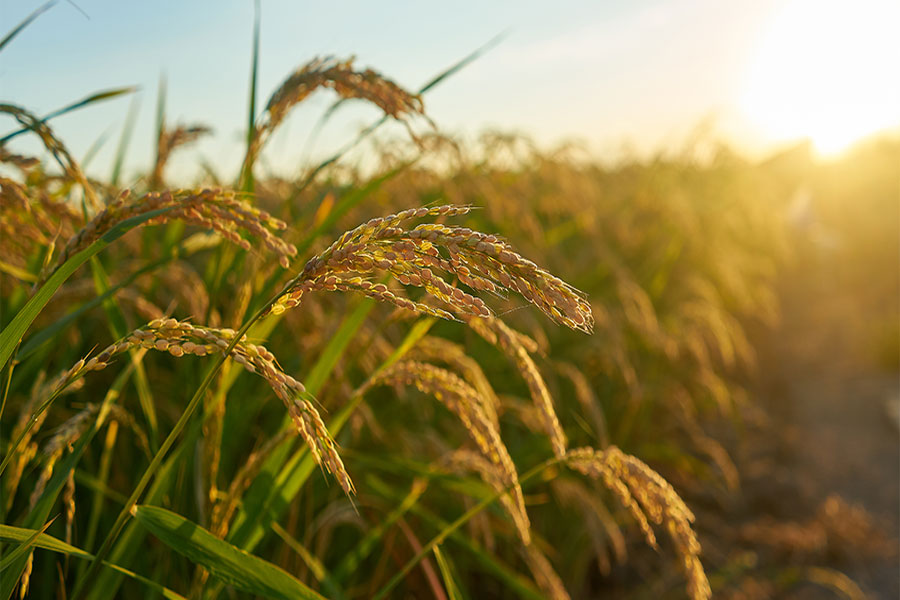Business
Demand for India’s rice likely to shoot up in global market as floods hit crop in Southeast Asian nations

Demand for Indian rice is expected to increase amid heavy flooding in countries such as Thailand and Vietnam, which have been dominant players for this staple grain in the global export market. The heavy floods along the Mekong River belt have caused severe damage to crops in the two Southeast Asian countries. The paddy fields have been particularly washed away giving rise to concerns over food security amid surging global food prices driven by the Russia-Ukraine war.
Even as sowing of the grain in India this year is estimated to be 17 per cent lower due to inadequate rains in states such as Bihar and Orissa, analysts said that there is no cause for any worry as the country is sitting on adequate stocks from last year. However they maintained that New Delhi must refrain from taking any “sudden decisions.”
“Such adhoc and knee jerk reaction and banning of outbound shipment create problems for Indian exporters, they find it difficult to get orders in the future,” Anil Ghanwat, senior leader of Shetkari Sangathana, a Maharashtra based farmers union earlier told India Narrative.
India accounts for about 40 per cent of the global rice supply.
“India’s rice #exports to benefit & rise to ~$10-12 bn as key competitors ie Thailand & Vietnam suffer from loss in yields & cost surge. #India likey to #export 22 out of the 53 MT #rice demanded globally with market share of 40% in 2022,” Sachchidanand Shukla, Chief Economist, Mahindra Group said in a tweet.
Indian rice is also less expensive compared to the grain sold by Thailand and Vietnam.
According to World Grain, an analysis website, shrinking the price spread with Thailand and Vietnam, Pakistani quotes rose $40 to $420 per tonne amid steady demand from China. “Indian quotes rose minimally by $5 to $350 per tonne and remain the lowest globally with large supplies,” it said.
Even as the price of Thai rice fell amid the uncertainties, it was more than the Indian rate.
The problem of flooding is not specific to Southeast Asia. Even Bangladesh and parts of India � especially the northeast have been in the grip of floods. But at the same time there are states which have received less rain.
“Sowing of paddy has been lower this year but a 17 per cent less sowing is nothing to cause any alarm. We have ample stocks, left from the last year’s yields�in fact due to large stocks, many farmers in Maharashtra and Tamil Nadu are also considering whether or not to sow paddy as then there will be problems related to storing. Our stocks are more than enough to feed our own people and export,” Ghanwat said.
Meanwhile, news organisation , Vietnam Plus as the Mekong River water level is rising steadily and people living along its two banks in Thailand have been warned to be ready for dealing with floods that can happen at any time.
The Mekong River belt is crucial for multiple crops. Besides paddy, beans, leafy vegetables, watermelon, chilies, various herbs, and many other varieties of vegetables are grown.
Business
Nifty surges over 1 pc this week led by bank, auto stocks

SHARE MARKET
Mumbai, Jan 3: The Indian equity benchmarks closed on a strong note this week, touching fresh all-time highs amid strong performance in the banking and auto sectors.
Nifty surged 1.05 per cent during the week and 0.70 per cent on the last trading day to 26,328. At close, Sensex was up 760 points or 0.67 per cent at 85,762. It surged 0.89 per cent during the week.
Bank Nifty also continued its outperformance and scaled fresh record highs above the 60,200 mark.
The Indian equities traded in a cautious tone till New Year, weighed down by persistent FII outflows and heightened global uncertainties. On New Year, the indices ended on a flat note, and on the last day of trading week, they touched fresh all-time highs.
Strong momentum was observed in the auto and PSU banking sectors, while sectoral rotation was evident in utilities as they gained traction on hopes of rising demand and increased industrial activity. Robust December auto sales indicate a broader uptick in economic activity during the festive-driven quarter.
Improving asset quality and expectations of accelerated credit growth drew investor interest toward PSU banking stocks, analysts said.
Conversely, FMCG index dipped 4 per cent for the week after the government announced a higher excise duty on cigarettes.
Broader indices outperformed benchmark indices for the week, with the Nifty Midcap100 up 1.74 per cent, while Nifty Smallcap100 edged up 0.77 per cent.
Precious metals continued their momentum, as trade disparity, supply constraints, geo-political tension, rate cut view and FII outflows continue to test the near-term risk appetite of investors.
According to analysts, a sustained hold by Nifty above 26,300 could accelerate the rally toward 26,500, with an extended upside potential toward 26,700 on strong follow-through. Bank Nifty is likely to continue outperforming the Nifty index in the near term, they added.
Key cues for investors going forward include US payroll and unemployment data for global market direction. Markets may move within a steady range as participants wait for clearer earnings‑led triggers and clarity on the India-US trade deal, market watchers said.
Business
New labour codes bring on board gig workers with 90-day employment

New Delhi, Jan 2: The Ministry of Labour and Employment has published the draft rules for the four labour codes, which also bring gig workers on board for various benefits such as minimum wage, health, occupational safety, and social security coverage.
The government has invited feedback from stakeholders on these draft rules and aims to finally roll out the entire package of four labour codes across the country from April 1.
Under the draft rules, in order to be eligible for the benefits, a gig or platform worker must be associated with an aggregator for at least 90 days in a financial year to qualify for social security benefits created by the Centre. If a worker is engaged with more than one aggregator, the minimum requirement is fixed at 120 days.
The notification, dated December 30, 2025, was issued a day before the gig and platform workers went on a flash strike for higher wages and better working conditions.
The rules clarify that a worker is considered “engaged” on any calendar day if they earn income for work done for an aggregator, regardless of how much they earn.
If a worker is associated with multiple aggregators, the number of engagement days will be added together across all aggregators. The draft also states that if a worker is engaged with three aggregators on the same calendar day, it will be counted as three separate days of engagement.
Regarding the minimum wage, the draft rules state that when the rate of wages for a day is fixed, then such amount shall be divided by eight for fixing the rate of wages for an hour and multiplied by twenty-six for fixing the rate of wages for a month. In case of a five-day working week, the hourly rate of minimum wages so calculated shall be used to derive the minimum wages for the day.
While fixing the minimum rates of wages, the Central government shall take into account the geographical area, experience in the area of employment, and level of skill required for working under the categories of unskilled, semiskilled, skilled, and highly skilled, the rules further state.
The four codes — the Code on Wages, 2019; the Industrial Relations Code, 2020; the Code on Social Security, 2020; and the Occupational Safety, Health and Working Conditions Code, 2020 — were notified on the same day.
The Labour Codes make it mandatory for employers to issue appointment letters to all workers, which provides written proof to ensure transparency, job security, and fixed employment. Earlier, no mandatory appointment letters were required.
Under the Code on Social Security, 2020, all workers, including gig and platform workers, will get social security coverage. All workers will get PF, ESIC, insurance, and other social security benefits. Earlier, there was only limited security coverage.
Under the Code on Wages, 2019, all workers will receive a statutory minimum wage payment, and timely payment will ensure financial security. Earlier, minimum wages applied only to scheduled industries or employments and large sections of workers remained uncovered.
Business
FAIFA urges government to roll back steep tax hike on tobacco products

New Delhi, Jan 2: The Federation of All India Farmer Associations (FAIFA) on Friday urged the government to roll back the notified excise rates on tobacco products and revise them to revenue-neutral rates, to disincentivise smuggling, and support domestic agriculture.
A stable taxation framework, FAIFA noted in a statement, is necessary to sustain farmer incomes, protect employment across the value chain, and align economic policy with long-term public health goals.
The Ministry of Finance notification ‘Chewing Tobacco, Jarda Scented Tobacco and Gutkha Packing Machines (Capacity Determination and Collection of Duty) Rules, 2026’ has imposed an excise duty of Rs 2,050-Rs 8,500 per 1,000 sticks, depending on cigarette length, effective February 1.
FAIFA said such a steep hike in taxes would force domestic manufacturers to raise prices of finished goods, which will lead to a drop in sales, hurting farmers supplies in return. This could cause a glut in the tobacco crop market in the near term, it added.
“While announcing GST 2.0 on September 4, 2025, Government had assured that in the case of tobacco products, GST would be charged at 40 per cent of the retail sales price, while the overall incidence of tax would be kept unchanged,” said Murali Babu, President, FAIFA.
He further added that the farming community across India has been holding on to this assurance of revenue neutrality and had welcomed the government’s decision to rationalise GST by restructuring rates and doing away with the 12 per cent slab, which helped reduce prices.
Appealing to the government, FAIFA leaders stressed that India’s legal cigarette prices are already among the least affordable globally when measured against per capita income, as reflected in World Health Organization’s (WHO) affordability index.
Current steep increase will render legal products unaffordable to a huge section of consumers, accelerating consumer migration to illegal channels, it argued. FAIFA appealed to the government to ensure that taxation policies do not punish those who have always remained within the law.
-

 Crime3 years ago
Crime3 years agoClass 10 student jumps to death in Jaipur
-

 Maharashtra1 year ago
Maharashtra1 year agoMumbai Local Train Update: Central Railway’s New Timetable Comes Into Effect; Check Full List Of Revised Timings & Stations
-

 Maharashtra1 year ago
Maharashtra1 year agoMumbai To Go Toll-Free Tonight! Maharashtra Govt Announces Complete Toll Waiver For Light Motor Vehicles At All 5 Entry Points Of City
-

 Maharashtra1 year ago
Maharashtra1 year agoFalse photo of Imtiaz Jaleel’s rally, exposing the fooling conspiracy
-

 National News1 year ago
National News1 year agoMinistry of Railways rolls out Special Drive 4.0 with focus on digitisation, cleanliness, inclusiveness and grievance redressal
-

 Maharashtra1 year ago
Maharashtra1 year agoMaharashtra Elections 2024: Mumbai Metro & BEST Services Extended Till Midnight On Voting Day
-

 National News1 year ago
National News1 year agoJ&K: 4 Jawans Killed, 28 Injured After Bus Carrying BSF Personnel For Poll Duty Falls Into Gorge In Budgam; Terrifying Visuals Surface
-

 Crime1 year ago
Crime1 year agoBaba Siddique Murder: Mumbai Police Unable To Get Lawrence Bishnoi Custody Due To Home Ministry Order, Says Report

















